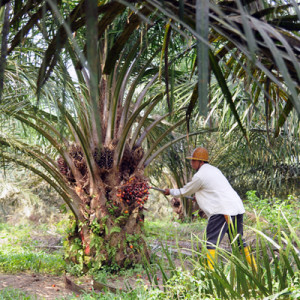Palm Oil , CO2 Emissions and the EPA
A team from the US Environmental Protection Agency (EPA) will soon visit Malaysia to learn from close range the global warming potential of the oil palm industry. Over the past few years, US experts have studied the oil palm plantation industry from a distant using satellite images of areas covered under forest, or agriculture such as oil palm plantations. The impression obtained through such modeling studies is translated into potential global warming implications based on the relative CO2 emissions of palm biodiesel. Initial results published by the EPA showed that palm oil biodiesel would only provide 17 % CO2 emissions saving compared to fossil diesel when used as fuel. This falls below the 20% threshold requirement for acceptance as a biodiesel raw material as stipulated under the RFS regulation in the US.
The EPA visitors will find Malaysia much smaller in size than the US. To reach a developed country status by 2020, Malaysia is going through various development activities. The small size of the country however, provides interesting statistics which may interest our visitors from the US. For example, Malaysia’s net CO2 emissions are only 50 million tonnes per year as compared to almost 7 billion tonnes from the US. Interestingly, the oil palm industry is a net sink or remover of CO2 and together with the forest sector, oil palm plantations were responsible for Malaysia being a net sink or net CO2 removal country in the year 2000.
Visitors to Malaysia will find the country indeed very green. Land designated for agriculture is planted with tree crops such as oil palm or rubber. Malaysia has between 56 and 62 % permanent forest area and 18% plantation tree crops. Therefore, almost 80% of the country is under tree cover. This extensive tree cover is a huge carbon sink which is not common in the US.
The EPA’s overall objective is to develop renewable fuels which can reduce carbon emissions. Although palm oil behaves as a carbon sink, and can offer the unique opportunity of a fuel that will greatly reduce CO2 emissions, US experts have precluded such considerations by developing models which look at an unbalanced view of the emission potential of the oil palm plantations.
There are serious implications should the EPA continue to ignore the potential of oil palm as a raw material source for biofuel. Malaysia, a developing country needs to develop its land assets. This is similar to past US developments undertaken to generate revenue to become a developed country. The US should not insist on developing countries to maintain more forest than it’s own adopted standard (33.2%) in order to declare soybean as an acceptable sustainable fuel. Otherwise, developing countries are unfairly penalized for being slow in developing their land assets. As long as developing countries maintain more than 33.2% of forest area, production of biofuels such as palm oil is deemed to be on agricultural land with no CO2 emission burden from land use change.
The oil palm however can offer more benefits. Both the US and EU are net importers of oils and fats which are needed for their food and biofuel industries. As palm oil is 11 times more high yielding than soybean oil, imports of palm oil will reduce the pressure on deforestation to grow soybean by a factor of 11 times. Oil palm allows Malaysia to maintain 50% of its land area as permanent forest while generating sufficient revenue to remain more than self sufficient in food availability. This avoided deforestation both locally and in other countries account for large savings in CO2 emissions, and the CO2 saving value should be credited to palm oil biofuel. Both the US and EU should be aware that future supplies of soybean and rapeseed oil are not able to match the growth in global demand for oils and fats.
The oil seed annual planting has been expanding by 5 million hectares per year, causing an equal size of deforestation annually to provide land for the oilseed crops globally. Malaysian oil palm cultivation took 100 years to reach its present planted area of 5 million hectares accounting for only 0.09 % of global agricultural area, yet it is supplying 30% of the world exports of oils and fats. Furthermore, palm oil is the only oil that is sustainably certified by international bodies for food and biofuel applications. Soya and rape oil cannot be certified sustainable as they will not qualify based on international standards.
Palm oil, soya and rapeseed form an oligopolistic market. Adopting a win-lose strategy for market dominance will backfire as all players will face a negative outcome. This has already occurred in the EU with a roll back in bio fuel targets from 10 to 5%. Huge investments in biodiesel capacity will be unutilised, and consumers will unnecessarily be forced to pay for expensive biofuel raw material.
The EPA may have received numerous reports by Environmental NGOs on deforestation impact of oil palm cultivation. These allegations are baseless as oil palm is planted on legitimate agricultural land and does not encroach into forest land which is protected by law to remain as permanent forest reserves. The visit by the EPA officials will certainly allow them to have a much better view of the oil palm plantations here in Malaysia which are planted on legitimate agricultural land. All plantations are registered and licensed by a government agency (MPOB). Oil palm cultivation is similar to other crops in terms of agricultural land utilization, only that it is more land efficient than competing crops such as soybean and rapeseed because of its superior yield.










Tan Sri, whatever happened to our biofuel industry? I thought somewhere in the late 90s, we were head on towards promoting B5 fuel in Malaysia, as replacement for diesel. TQ.
Answer: B5 is now implemented in KL, Selangor, NS and Malacca, the central region. Next phase would be the north and south regions. Blending facilities are being installed. The subsequent phase should be for Sabah and Sarawak.
It’s time for the EPA to wake up to the fact that the anti-palm oil campaigns run by “green” NGOs are planned and funded by the European Commission to protect the EU’s own edible oilseed crops such as sunflower and rapeseed oil who are otherwise hapless in competing against the hyper yielding palm oil!
Dear Sir,
Thank you sir for such an enlightening thought and information.
Best Regards,
Sumeet Verma
The EPA should stop oppressing the developing world!!
Hmm… never knew.
The EPA is just a neo colonialist agency used to protect American produce from time to time!
The EPA will visit palm oil plantations accompanied by various teams ranging from green NGOs and palm oil industry officials. Hope the voice of reason will prevail over the ones whose existence depends on payola!
Hope that cool heads will rule when the EPA visits Malaysia.